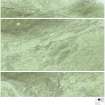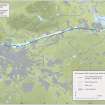Old Kilpatrick
Roman Fort (Roman)
Site Name Old Kilpatrick
Classification Roman Fort (Roman)
Alternative Name(s) Gavinburn Bus Depot
Canmore ID 43327
Site Number NS47SE 8
NGR NS 45929 73120
Datum OSGB36 - NGR
Permalink http://canmore.org.uk/site/43327
- Council West Dunbartonshire
- Parish Old Kilpatrick (Clydebank)
- Former Region Strathclyde
- Former District Clydebank
- Former County Dunbartonshire
NS47SE 8 4600 7315
(NS 4600 7315) ROMAN FORT (R) (site of)
OS 50" map (1964).
For adjoining length of Antonine Wall, see NS47SE 83.00.
Until 1913 the site of the west terminal fort of the Antonine Wall was thought to have been at or near Chapel Hill (NS 457 732), although in 1790 (J M Morrison MS note, late 18th century) discoveries were made during the construction of the Forth-Clyde Canal of what is now known to be the bath-house of the actual fort.
First proved by excavation in 1913 (G Macdonald 1915), the site of the fort was more fully excavated in 1923-4 (S N Miller 1928) before the greater part of it was buried by a housing scheme. Further excavations in 1931 confirmed the outline of the fort, its defences, and their relationship to the Antonine Wall.
The fort measured internally 408ft E-W by 442ft N-S, and covered an area of 4 1/2 acres. The bath-house had been situated in an annexe to the south. Full excavation reports and plans given by Miller (1928) and Macdonald (1932).
J Bruce 1893; G Macdonald 1934
The site of the fort is now completely built over and there are no extant remains.
Visited by OS (WMJ) 27 March 1951, (JLD) 30 November 1956 and (DS) 16 January 1957.
No change.
Visited by OS (JRL) 18 January 1980.
A zone N of Dumbarton Road, formerly occupied by a garage, has been redeveloped for housing. Limited excavation in 1988 with the aid of a machine established the edges of the two outer ditches which lay in the expected position (L J F Keppie 1988). The inner of the two was 2.5m wide, the outer 4-4.5m.
S S Frere 1989.
NS 460 731. During August 1994, GUARD carried out excavations at the site of a proposed extension to a bus-wash facility at the Gavinburn Bus Depot, Old Kilpatrick. The site was known to overlay the Roman fort. It was anticipated that the extension might impinge on the ditches and possible road line outside the SW corner of the fort. The areas excavated were to be sites of concrete foundations and associated drainage works. A total of fifteen small trenches were opened within an overall area of 16m by 7m.
Of the areas investigated, five revealed archaeological remains and none of the features recorded in any one trench appeared to relate to those in any of the other trenches. No evidence for the fort ditches was uncovered, placing the excavations between a break in the defences. Various discrete features, mostly structural in form were recorded along with two substantial rough stone spreads aligned E-W. One trench revealed the remains of a probable road surface.
It was thought that construction of the bus depot may have disturbed the underlying remains, but all archaeological deposits were well protected by a thick overburden of ploughsoil, itself highly compacted by vehicles.
Sponsor: Kelvin Central Buses.
K Speller 1994c.
A study of utilitarian pottery from the Antonine Wall has distinguished small numbers of locally made vessels with North African affinities at nine or 10 forts. Similar vessels at Chester and others made by Legio XX at the Holt works depot, one with a potter's graffito in neo-Punic, suggest the presence of North Africans. Detachments sent from Britain to Pius' Mauretanian war of AD 146-9 may have brought North Africans back with them to Britain (possibly including legionary recruits or transfers, and Moorish irregulars or levies). At the western sector of the Antonine Wall, changes in the legionary work-stints may be linked to troop reductions for the war, as the mural barrier and Bearsden and Duntocher fort interiors were still unfinished. After the conflict, Bearsden and Duntocher were each partitioned to make an annexe and their internal buildings re-planned and completed; a programme of annexe construction began at other forts, and secondary alterations were made to many existing fort interiors. All may be connected with changes in units or in the composition of the returning garrisons, now perhaps mixed and augmented with small numbers of North African troops. Possible epigraphic evidence is examined.
V Swan 1999.
Antiquarian Observation (1790)
In 1790 (J M Morrison MS note, late 18th century) discoveries were made during the construction of the Forth-Clyde Canal, which consisted of what is now known to be the bath-house of the Old Kilpatrick fort.
Excavation (1913)
Until 1913 the site of the west terminal fort of the Antonine Wall was thought to have been at or near Chapel Hill (NS 457 732), though discoveries made in the 1790's indicated that there was activity in the Old Kilpatrick area.
The location of the Old Kilpatrick fort was affirmed through excavation in 1913 (G Macdonald 1915).
Excavation (1923 - 1924)
A fuller excavation was carried out by Miller in 1923-4 (S N Miller 1928) before the greater part of the fort was covered by a housing scheme.
During Miller's excavation an area of compacted gravel was discovered to the east of the fort on the south side of the Antonine Wall. It was interpreted as a possible road surface (S N Miller 1928 7-9).
Excavation (1931)
Further excavations in 1931 confirmed the outline of the fort, its defences, and their relationship to the Antonine Wall (G Macdonald 1934). The fort measured internally 408ft E-W by 442ft N-S, and covered an area of 4 1/2 acres. The bath-house had been situated in an annexe to the south. Full excavation reports and plans given by Miller (1928) and Macdonald (1932).
J Bruce 1893; G Macdonald 1934
Field Visit (27 March 1951)
The site of the fort is now completely built over and there are no extant remains.
Visited by OS (WMJ) 27 March 1951
Field Visit (30 November 1956)
The site of the fort is now completely built over and there are no extant remains.
Visited by OS (JLD) 30 November 1956
Field Visit (16 January 1957)
The site of the fort is now completely built over and there are no extant remains.
Visited by OS (DS) 16 January 1957.
Note (1978)
Old Kilpatrick NS 460 731 NS47SE 8
This fort, the westermost station on the Antonine Wall, measured 143m by 134 m (1.9ha) over the rampart. Excavation has shown that it was built prior to the construction of the Wall in this sector, and has produced evidence for a possible Agricolan fort on the site. To the S of the fort there was an annexe, in which a bath-house was found in the late 18th century.
RCAHMS 1978
(Miller 1928; Macdonald 1932, 219-42; Macdonald 1934, 332-41; Robertson 1973, 88-91)
Field Visit (18 January 1980)
No change from earlier observations.
Visited by OS (JRL) 18 January 1980
Excavation (March 1988)
A zone N of Dumbarton Road, formerly occupied by a garage, has been redeveloped for housing. Limited excavation in 1988 with the aid of a machine established the edges of the two outer ditches which lay in the expected position (L J F Keppie 1988). The inner of the two was 2.5m wide, the outer 4-4.5m.
S S Frere 1989
Excavation (29 August 1994 - 3 September 1994)
NS 460 731. During August 1994, GUARD carried out excavations at the site of a proposed extension to a bus-wash facility at the Gavinburn Bus Depot, Old Kilpatrick. The site was known to overlay the Roman fort. It was anticipated that the extension might impinge on the ditches and possible road line outside the SW corner of the fort. The areas excavated were to be sites of concrete foundations and associated drainage works. A total of fifteen small trenches were opened within an overall area of 16m by 7m.
Of the areas investigated, five revealed archaeological remains and none of the features recorded in any one trench appeared to relate to those in any of the other trenches. No evidence for the fort ditches was uncovered, placing the excavations between a break in the defences. Various discrete features, mostly structural in form were recorded along with two substantial rough stone spreads aligned E-W. One trench revealed the remains of a probable road surface.
It was thought that construction of the bus depot may have disturbed the underlying remains, but all archaeological deposits were well protected by a thick overburden of ploughsoil, itself highly compacted by vehicles.
Sponsor: Kelvin Central Buses.
K Speller 1994c.
Watching Brief (14 July 1999 - 27 July 1999)
Between the 14th and 27th of July 1999, AOC conducted a watching brief at the Gavin Bus Depot. The area observed covered the combined Antonine Wall and Roman fort defences.
Reference (1999)
A study of utilitarian pottery from the Antonine Wall has distinguished small numbers of locally made vessels with North African affinities at nine or 10 forts. Similar vessels at Chester and others made by Legio XX at the Holt works depot, one with a potter's graffito in neo-Punic, suggest the presence of North Africans. Detachments sent from Britain to Pius' Mauretanian war of AD 146-9 may have brought North Africans back with them to Britain (possibly including legionary recruits or transfers, and Moorish irregulars or levies). At the western sector of the Antonine Wall, changes in the legionary work-stints may be linked to troop reductions for the war, as the mural barrier and Bearsden and Duntocher fort interiors were still unfinished. After the conflict, Bearsden and Duntocher were each partitioned to make an annexe and their internal buildings re-planned and completed; a programme of annexe construction began at other forts, and secondary alterations were made to many existing fort interiors. All may be connected with changes in units or in the composition of the returning garrisons, now perhaps mixed and augmented with small numbers of North African troops. Possible epigraphic evidence is examined.
V Swan 1999
Publication Account (2008)
A 1:25000 scale map of the Antonine Wall was published by RCAHMS in 2008. The map shows the course of the Antonine Wall on a modern map base, including areas where the Wall is in public ownership or care and can be visited. The data had been collated as part of the project to prepare maps for the World Heritage Site nomination bid.








































